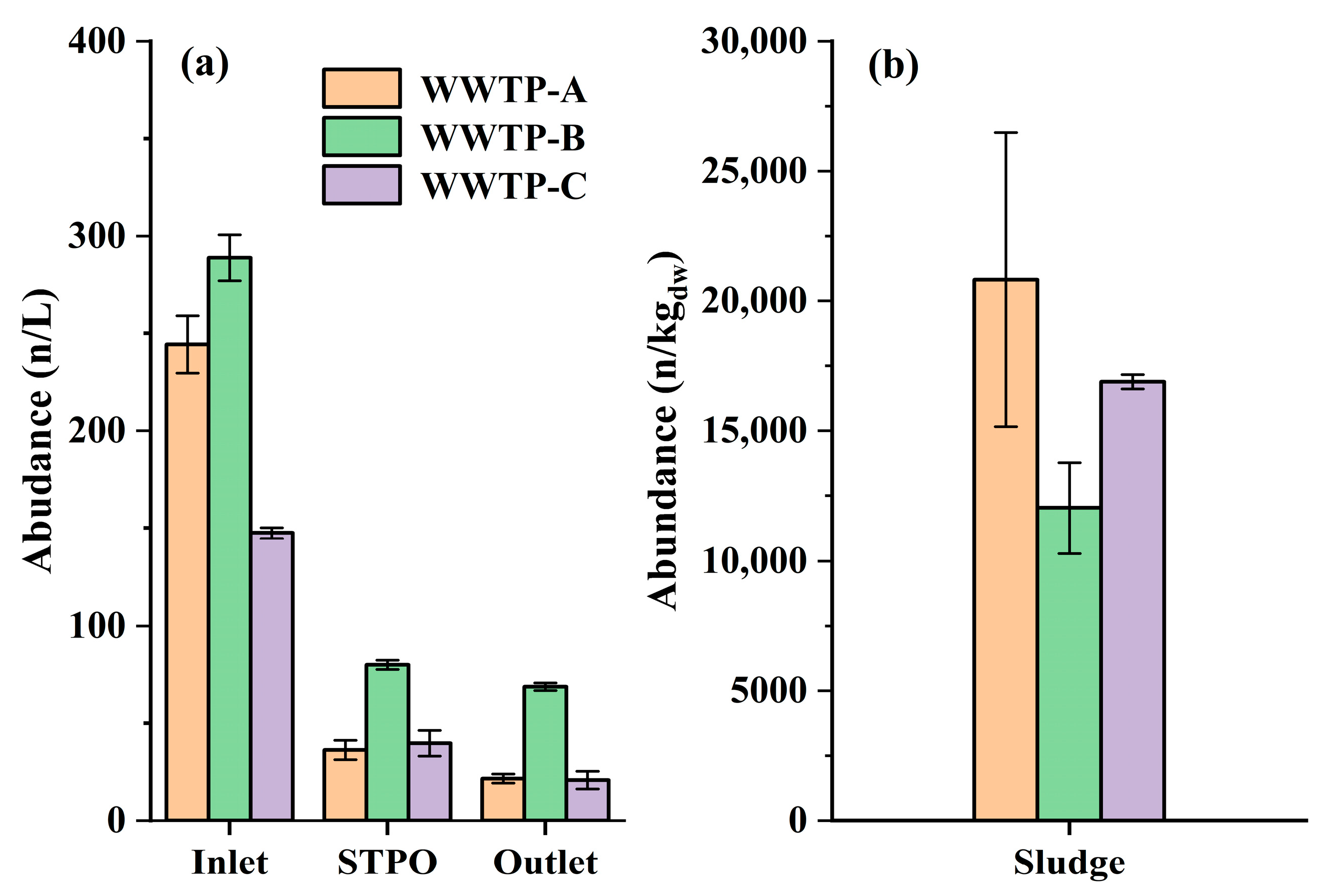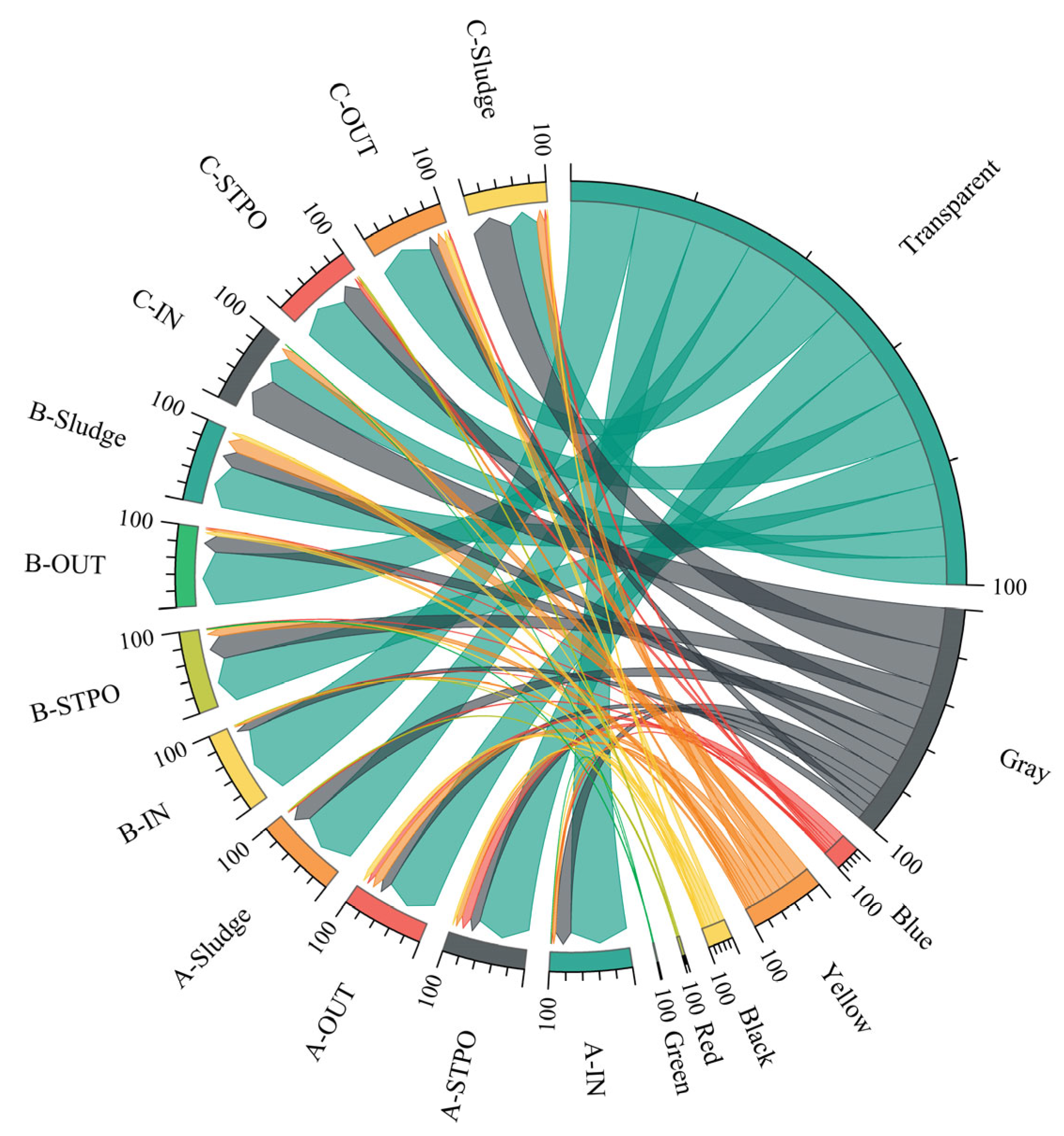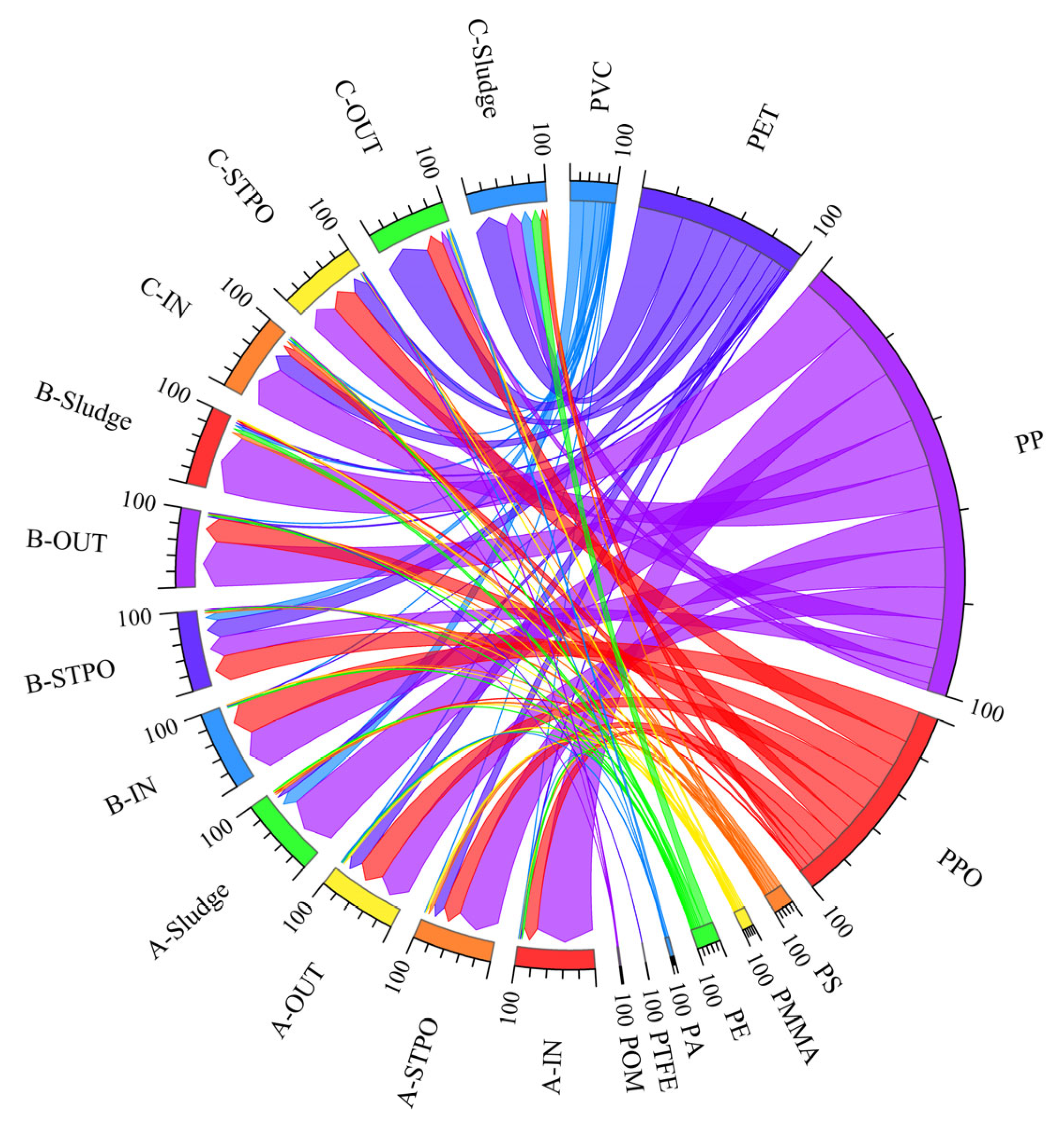Occurrence and Removal of Microplastics in Tertiary Wastewater Treatment Plants: A Case Study of Three Plants in Zhengzhou, China
Abstract
1. Introduction
2. Materials and Methods
2.1. Field Sample Collection
2.2. Extraction of MPs
2.3. Identification Method of MPs
2.4. Quality Control
2.5. Data Analysis
3. Results and Discussion
3.1. Abundance of the MPs
3.2. Size and Shape
3.3. Color and Polymer Type
3.4. Removal Efficacy of the MPs
3.5. Limitations
4. Conclusions
Supplementary Materials
Author Contributions
Funding
Data Availability Statement
Conflicts of Interest
References
- Bergmann, M.; Collard, F.; Fabres, J.; Gabrielsen, G.W.; Provencher, J.F.; Rochman, C.M.; van Sebille, E.; Tekman, M.B. Plastic pollution in the arctic. Nat. Rev. Earth. Environ. 2022, 3, 323–337. [Google Scholar] [CrossRef]
- Suzuki, G.; Uchida, N.; Tanaka, K.; Matsukami, H.; Kunisue, T.; Takahashi, S.; Viet, P.H.; Kuramochi, H.; Osako, M. Mechanical recycling of plastic waste as a point source of microplastic pollution. Environ. Pollut. 2022, 303, 119114. [Google Scholar] [CrossRef] [PubMed]
- Mazhandu, Z.S.; Muzenda, E. Global plastic waste pollution challenges and management. In Proceedings of the 2019 7th International Renewable and Sustainable Energy Conference (IRSEC), Agadir, Morocco, 27–30 November 2019; pp. 1–8. [Google Scholar] [CrossRef]
- Thompson, R.; Olsen, Y.; Mitchell, R.; Davis, A.; Russell, A. Lost at sea: Where is all the plastic? Science 2004, 304, 838. [Google Scholar] [CrossRef]
- Xiang, Y.; Jiang, L.; Zhou, Y.; Luo, Z.; Zhi, D.; Yang, J.; Lam, S.S. Microplastics and environmental pollutants: Key interaction and toxicology in aquatic and soil environments. J. Hazard. Mater. 2022, 422, 126843. [Google Scholar] [CrossRef]
- Abelouah, M.R.; Ben-Haddad, M.; Hajji, S.; De-la-Torre, G.E.; Aziz, T.; Abou Oualid, J.; Banni, M.; Alla, A.A. Floating microplastics pollution in the central atlantic ocean of morocco: Insights into the occurrence, characterization, and fate. Mar. Pollut. Bull. 2022, 182, 113969. [Google Scholar] [CrossRef]
- Fan, S.; Yan, Z.; Qiao, L.; Gui, F.; Li, T.; Yang, Q.; Zhang, X.; Ren, C. Biological effects on the migration and transformation of microplastics in the marine environment. Mar. Environ. Res. 2023, 185, 105875. [Google Scholar] [CrossRef]
- Xu, D.; Gao, B.; Wan, X.; Peng, W.; Zhang, B. Influence of catastrophic flood on microplastics organization in surface water of the three gorges reservoir, China. Water Res. 2022, 211, 118018. [Google Scholar] [CrossRef]
- WHO. Microplastics in Drinking-Water; 9241516194; World Health Organization (WHO): Geneva, Switzerland, 2019. [Google Scholar]
- Fan, J.; Zou, L.; Duan, T.; Qin, L.; Qi, Z.; Sun, J. Occurrence and distribution of microplastics in surface water and sediments in China’s inland water systems: A critical review. J. Clean. Prod. 2022, 331, 129968. [Google Scholar] [CrossRef]
- Chan, S.S.; Khoo, K.S.; Chew, K.W.; Ling, T.C.; Show, P.L. Recent advances biodegradation and biosorption of organic compounds from wastewater: Microalgae-bacteria consortium—A review. Bioresour. Technol. 2022, 344, 126159. [Google Scholar] [CrossRef]
- Sabliy, L.; Kuzminskiy, Y.; Zhukova, V.; Kozar, M.; Sobczuk, H. New approaches in biological wastewater treatment aimed at removal of organic matter and nutrients. Ecol. Chem. Eng. 2019, 26, 331–343. [Google Scholar] [CrossRef]
- Liu, W.; Zhang, J.; Liu, H.; Guo, X.; Zhang, X.; Yao, X.; Cao, Z.; Zhang, T. A review of the removal of microplastics in global wastewater treatment plants: Characteristics and mechanisms. Environ. Int. 2021, 146, 106277. [Google Scholar] [CrossRef] [PubMed]
- Gatidou, G.; Arvaniti, O.S.; Stasinakis, A.S. Review on the occurrence and fate of microplastics in sewage treatment plants. J. Hazard. Mater. 2019, 367, 504–512. [Google Scholar] [CrossRef] [PubMed]
- Sheriff, I.; Yusoff, M.S.; Halim, H.B. Microplastics in wastewater treatment plants: A review of the occurrence, removal, impact on ecosystem, and abatement measures. J. Water Process Eng. 2023, 54, 104039. [Google Scholar] [CrossRef]
- Ahmed, S.F.; Islam, N.; Tasannum, N.; Mehjabin, A.; Momtahin, A.; Chowdhury, A.A.; Almomani, F.; Mofijur, M. Microplastic removal and management strategies for wastewater treatment plants. Chemosphere 2024, 347, 140648. [Google Scholar] [CrossRef] [PubMed]
- Parashar, N.; Hait, S. Occurrence and removal of microplastics in a hybrid growth sewage treatment plant from bihar, india: A preliminary study. J. Clean. Prod. 2022, 376, 134295. [Google Scholar] [CrossRef]
- Egea-Corbacho, A.; Martín-García, A.P.; Franco, A.A.; Quiroga, J.M.; Andreasen, R.R.; Jørgensen, M.K.; Christensen, M.L. Occurrence, identification and removal of microplastics in a wastewater treatment plant compared to an advanced mbr technology: Full-scale pilot plant. J. Environ. Chem. Eng. 2023, 11, 109644. [Google Scholar] [CrossRef]
- Rajala, K.; Grönfors, O.; Hesampour, M.; Mikola, A. Removal of microplastics from secondary wastewater treatment plant effluent by coagulation/flocculation with iron, aluminum and polyamine-based chemicals. Water Res. 2020, 183, 116045. [Google Scholar] [CrossRef] [PubMed]
- Xu, R.; Yang, Z.; Niu, Y.; Xu, D.; Wang, J.; Han, J.; Wang, H. Removal of microplastics and attached heavy metals from secondary effluent of wastewater treatment plant using interpenetrating bipolar plate electrocoagulation. Sep. Purif. Technol. 2022, 290, 120905. [Google Scholar] [CrossRef]
- Arslan-Alaton, I.; Karatas, A.; Pehlivan, Ö.; Ucun, O.K.; Ölmez-Hancı, T. Effect of uv-a-assisted iron-based and uv-c-driven oxidation processes on organic matter and antibiotic resistance removal in tertiary treated urban wastewater. Catal. Today 2021, 361, 152–158. [Google Scholar] [CrossRef]
- Zahmatkesh, S.; Bokhari, A.; Karimian, M.; Zahra, M.M.A.; Sillanpää, M.; Panchal, H.; Alrubaie, A.J.; Rezakhani, Y. A comprehensive review of various approaches for treatment of tertiary wastewater with emerging contaminants: What do we know? Environ. Monit. Assess. 2022, 194, 884. [Google Scholar] [CrossRef]
- Reddy, A.S.; Nair, A.T. The fate of microplastics in wastewater treatment plants: An overview of source and remediation technologies. Environ. Technol. Innov. 2022, 28, 102815. [Google Scholar] [CrossRef]
- Shukla, R.; Ahammad, S.Z. Performance assessment of a modified trickling filter and conventional activated sludge process along with tertiary treatment in removing emerging pollutants from urban sewage. Sci. Total Environ. 2023, 858, 159833. [Google Scholar] [CrossRef] [PubMed]
- Bao, R.; Wang, Z.; Qi, H.; Mehmood, T.; Cai, M.; Zhang, Y.; Yang, R.; Peng, L.; Liu, F. Occurrence and distribution of microplastics in wastewater treatment plant in a tropical region of China. J. Clean. Prod. 2022, 349, 131454. [Google Scholar] [CrossRef]
- Kittipongvises, S.; Phetrak, A.; Hongprasith, N.; Lohwacharin, J. Unravelling capability of municipal wastewater treatment plant in thailand for microplastics: Effects of seasonality on detection, fate and transport. J. Environ. Manag. 2022, 302, 113990. [Google Scholar] [CrossRef] [PubMed]
- Radityaningrum, A.D.; Trihadiningrum, Y.; Soedjono, E.S.; Herumurti, W. Microplastic contamination in water supply and the removal efficiencies of the treatment plants: A case of surabaya city, indonesia. J. Water Process Eng. 2021, 43, 102195. [Google Scholar] [CrossRef]
- Hajji, S.; Ben-Haddad, M.; Abelouah, M.R.; De-la-Torre, G.E.; Alla, A.A. Occurrence, characteristics, and removal of microplastics in wastewater treatment plants located on the moroccan atlantic: The case of agadir metropolis. Sci. Total Environ. 2023, 862, 160815. [Google Scholar] [CrossRef] [PubMed]
- Harley-Nyang, D.; Memon, F.A.; Jones, N.; Galloway, T. Investigation and analysis of microplastics in sewage sludge and biosolids: A case study from one wastewater treatment works in the UK. Sci. Total Environ. 2022, 823, 153735. [Google Scholar] [CrossRef] [PubMed]
- Min, R.; Ma, K.; Zhang, H.; Zhang, J.; Yang, S.; Zhou, T.; Zhang, G. Distribution and risk assessment of microplastics in liujiaxia reservoir on the upper yellow river. Chemosphere 2023, 320, 138031. [Google Scholar] [CrossRef] [PubMed]
- Li, L.; Geng, S.; Wu, C.; Song, K.; Wang, Q. Microplastics contamination in different trophic state lakes along the middle and lower reaches of yangtze river basin. Environ. Pollut. 2019, 254, 112951. [Google Scholar] [CrossRef]
- Long, Y.; Zhou, Z.; Yin, L.; Wen, X.; Xiao, R.; Du, L.; Zhu, L.; Liu, R.; Xu, Q.; Li, H. Microplastics removal and characteristics of constructed wetlands wwtps in rural area of changsha, China: A different situation from urban wwtps. Sci. Total Environ. 2022, 811, 152352. [Google Scholar] [CrossRef]
- Franco, A.; Arellano, J.; Albendín, G.; Rodríguez-Barroso, R.; Zahedi, S.; Quiroga, J.M.; Coello, M.D. Mapping microplastics in cadiz (Spain): Occurrence of microplastics in municipal and industrial wastewaters. J. Water Process Eng. 2020, 38, 101596. [Google Scholar] [CrossRef]
- Iyare, P.U.; Ouki, S.K.; Bond, T. Microplastics removal in wastewater treatment plants: A critical review. Environ. Sci. Water Res. Technol. 2020, 6, 2664–2675. [Google Scholar] [CrossRef]
- Ahmed, A.S.; Billah, M.M.; Ali, M.M.; Bhuiyan, M.K.A.; Guo, L.; Mohinuzzaman, M.; Hossain, M.B.; Rahman, M.S.; Islam, M.S.; Yan, M. Microplastics in aquatic environments: A comprehensive review of toxicity, removal, and remediation strategies. Sci. Total Environ. 2023, 876, 162414. [Google Scholar] [CrossRef] [PubMed]
- Franco, A.; Martín-García, A.; Egea-Corbacho, A.; Arellano, J.; Albendín, G.; Rodríguez-Barroso, R.; Quiroga, J.; Coello, M. Assessment and accumulation of microplastics in sewage sludge at wastewater treatment plants located in Cádiz, Spain. Environ. Pollut. 2023, 317, 120689. [Google Scholar] [CrossRef] [PubMed]
- Li, Y.; Meng, Y.; Qin, L.; Shen, M.; Qin, T.; Chen, X.; Chai, B.; Liu, Y.; Dou, Y.; Duan, X. Occurrence and removal efficiency of microplastics in four drinking water treatment plants in Zhengzhou, China. Water 2023, 16, 131. [Google Scholar] [CrossRef]
- Conley, K.; Clum, A.; Deepe, J.; Lane, H.; Beckingham, B. Wastewater treatment plants as a source of microplastics to an urban estuary: Removal efficiencies and loading per capita over one year. Water Res. X 2019, 3, 100030. [Google Scholar] [CrossRef] [PubMed]
- Alvim, C.B.; Bes-Piá, M.; Mendoza-Roca, J.A. Separation and identification of microplastics from primary and secondary effluents and activated sludge from wastewater treatment plants. Chem. Eng. J. 2020, 402, 126293. [Google Scholar] [CrossRef]
- Liu, Z.; You, X.-y. Recent progress of microplastic toxicity on human exposure base on in vitro and in vivo studies. Sci. Total Environ. 2023, 903, 166766. [Google Scholar] [CrossRef] [PubMed]
- Tiffin, L.; Hazlehurst, A.; Sumner, M.; Taylor, M. Reliable quantification of microplastic release from the domestic laundry of textile fabrics. J. Text. Inst. 2022, 113, 558–566. [Google Scholar] [CrossRef]
- Grillo, J.F.; López-Ordaz, A.; Hernández, A.J.; Catarí, E.; Sabino, M.A.; Ramos, R. Synthetic microfiber emissions from denim industrial washing processes: An overlooked microplastic source within the manufacturing process of blue jeans. Sci. Total Environ. 2023, 884, 163815. [Google Scholar] [CrossRef]
- Cesa, F.S.; Turra, A.; Checon, H.H.; Leonardi, B.; Baruque-Ramos, J. Laundering and textile parameters influence fibers release in household washings. Environ. Pollut. 2020, 257, 113553. [Google Scholar] [CrossRef]
- Liu, X.; Yuan, W.; Di, M.; Li, Z.; Wang, J. Transfer and fate of microplastics during the conventional activated sludge process in one wastewater treatment plant of China. Chem. Eng. J. 2019, 362, 176–182. [Google Scholar] [CrossRef]
- Fagiano, V.; Compa, M.; Alomar, C.; Ríos-Fuster, B.; Morato, M.; Capó, X.; Deudero, S. Breaking the paradigm: Marine sediments hold two-fold microplastics than sea surface waters and are dominated by fibers. Sci. Total Environ. 2023, 858, 159722. [Google Scholar] [CrossRef] [PubMed]
- Ríos, J.M.; Tesitore, G.; de Mello, F.T. Does color play a predominant role in the intake of microplastics fragments by freshwater fish: An experimental approach with psalidodon eigenmanniorum. Environ. Sci. Pollut. Res. 2022, 29, 49457–49464. [Google Scholar] [CrossRef] [PubMed]
- Liu, X.; Deng, Q.; Zheng, Y.; Wang, D.; Ni, B.J. Microplastics aging in wastewater treatment plants: Focusing on physicochemical characteristics changes and corresponding environmental risks. Water Res. 2022, 221, 118780. [Google Scholar] [CrossRef] [PubMed]
- Chu, J.; Zhou, Y.; Cai, Y.; Wang, X.; Li, C.; Liu, Q. Flow and stock accumulation of plastics in China: Patterns and drivers. Sci. Total Environ. 2022, 852, 158513. [Google Scholar] [CrossRef] [PubMed]
- Šaravanja, A.; Pušić, T.; Dekanić, T. Microplastics in Wastewater by Washing Polyester Fabrics. Materials 2022, 15, 2683. [Google Scholar] [CrossRef] [PubMed]
- Hamidian, A.H.; Ozumchelouei, E.J.; Feizi, F.; Wu, C.; Zhang, Y.; Yang, M. A review on the characteristics of microplastics in wastewater treatment plants: A source for toxic chemicals. J. Clean. Prod. 2021, 295, 126480. [Google Scholar] [CrossRef]
- Petroody, S.S.A.; Hashemi, S.H.; van Gestel, C.A. Transport and accumulation of microplastics through wastewater treatment sludge processes. Chemosphere 2021, 278, 130471. [Google Scholar] [CrossRef]
- Zhang, B.; Wu, Q.; Gao, S.; Ruan, Y.; Qi, G.; Guo, K.; Zeng, J. Distribution and removal mechanism of microplastics in urban wastewater plants systems via different processes. Environ. Pollut. 2023, 320, 121076. [Google Scholar] [CrossRef]
- Bilgin, M.; Yurtsever, M.; Karadagli, F. Microplastic removal by aerated grit chambers versus settling tanks of a municipal wastewater treatment plant. J. Water Process Eng. 2020, 38, 101604. [Google Scholar] [CrossRef]
- Ali, I.; Ding, T.; Peng, C.; Naz, I.; Sun, H.; Li, J.; Liu, J. Micro-and nanoplastics in wastewater treatment plants: Occurrence, removal, fate, impacts and remediation technologies—A critical review. Chem. Eng. J. 2021, 423, 130205. [Google Scholar] [CrossRef]
- Pivokonský, M.; Pivokonská, L.; Novotná, K.; Čermáková, L.; Klimtová, M. Occurrence and fate of microplastics at two different drinking water treatment plants within a river catchment. Sci. Total Environ. 2020, 741, 140236. [Google Scholar] [CrossRef] [PubMed]
- Gao, Z.; Chen, L.; Cizdziel, J.; Huang, Y. Research progress on microplastics in wastewater treatment plants: A holistic review. J. Environ. Manag. 2023, 325, 116411. [Google Scholar] [CrossRef] [PubMed]
- Meng, X.; Bao, T.; Hong, L.; Wu, K. Occurrence characterization and contamination risk evaluation of microplastics in hefei’s urban wastewater treatment plant. Water 2023, 15, 686. [Google Scholar] [CrossRef]
- Franco, A.; Arellano, J.; Albendín, G.; Rodríguez-Barroso, R.; Quiroga, J.; Coello, M. Microplastic pollution in wastewater treatment plants in the city of cádiz: Abundance, removal efficiency and presence in receiving water body. Sci. Total Environ. 2021, 776, 145795. [Google Scholar] [CrossRef]
- Tang, N.; Liu, X.; Xing, W. Microplastics in wastewater treatment plants of wuhan, central China: Abundance, removal, and potential source in household wastewater. Sci. Total Environ. 2020, 745, 141026. [Google Scholar] [CrossRef]






| WWTP | Mean Abundance of MPs (n/L) | Removal Efficacy 1 (%) | Removal Efficacy 2 (%) | Removal Efficacy 3 (%) | ||
|---|---|---|---|---|---|---|
| IN | STOP | OUT | ||||
| A | 244.3 ± 14.7 | 36.3 ± 5.0 | 21.6 ± 2.4 | 85.1 | 91.2 | 40.5 |
| B | 288.8 ± 11.8 | 80.0 ± 2.4 | 68.8 ± 2.0 | 72.3 | 76.2 | 14.0 |
| C | 147.5 ± 2.6 | 39.7 ± 6.6 | 20.8 ± 4.6 | 73.1 | 85.9 | 47.6 |
| Location | Capacity (104 m3/d) | Treatment | Influent (n/L) | Effluent (n/L) | Removal Efficacy (%) | Dominant Polymer Types | References |
|---|---|---|---|---|---|---|---|
| Hefei/China | 10 | Primary, secondary (AAO), tertiary | 101.9 ± 17.6 (Dry) 108.7 ± 20.1 (Rain) | 108.7 ± 20.1 (Dry) 26.3 ± 5.1 (Rain) | 87.7 (Dry) 83.5 (Rain) | PA, PF, PE | [57] |
| Silkeborg/Denmark | 105,000 (Person Equivalents) | Primary, secondary (MBR), tertiary | 507 ± 70 | 507 ± 70 | 99.69 | PHDA, PE | [18] |
| Agadir/Morocco | 0.7 | secondary (Activated sludge), tertiary | 188 ± 29.04 | 188 ± 29.04 | 72 | PE | [28] |
| Agadir/Morocco | 3.0 | Primary, secondary (Filtration-percolation), tertiary | 188 ± 29.04 | 188 ± 29.04 | 81 | PE | [28] |
| Guiyang/China | 1.0 | Primary, secondary (SBR/AAO/CAST), tertiary | 32.5 ± 1.0 | 5.0 ± 0.4 | 84.6 | PE, PP | [52] |
| Changsha/China | 0.075 | Primary, secondary (AAO), tertiary | 70.00 ± 18.67 | 19.33 ± 1.25 | 72.4 | PE, PS | [32] |
| Cádiz/Spain (urban) | 5.2 | Primary, secondary (Activated sludge) | 645.03 ± 182.24 | 16.40 ± 7.85 | 97 | PVC, PA | [58] |
| Cádiz/Spain (Industrial) | 0.008 | Primary, secondary (Activated sludge) | 1567.49 ± 413.18 | 1567.49 ± 413.18 | 91.62 | PVC, HDPE, PE | [58] |
| Wuhan/China | 7 | Primary, secondary (Activated sludge), tertiary | 23.3 ± 2.0 | 7.9 ± 1.1 | 66.1 | PVC, PE, PP | [59] |
| Wuhan/China | 30 | Primary, secondary (Activated sludge), tertiary | 80.5 ± 6.3 | 30.3 ± 3.0 | 62.7 | PVE, PE, PP | [59] |
Disclaimer/Publisher’s Note: The statements, opinions and data contained in all publications are solely those of the individual author(s) and contributor(s) and not of MDPI and/or the editor(s). MDPI and/or the editor(s) disclaim responsibility for any injury to people or property resulting from any ideas, methods, instructions or products referred to in the content. |
© 2024 by the authors. Licensee MDPI, Basel, Switzerland. This article is an open access article distributed under the terms and conditions of the Creative Commons Attribution (CC BY) license (https://creativecommons.org/licenses/by/4.0/).
Share and Cite
Li, Y.; Qin, T.; Bai, X.; Wu, W.; Chen, X.; Shen, M.; Qin, L.; Dou, Y.; Duan, X. Occurrence and Removal of Microplastics in Tertiary Wastewater Treatment Plants: A Case Study of Three Plants in Zhengzhou, China. Processes 2024, 12, 803. https://doi.org/10.3390/pr12040803
Li Y, Qin T, Bai X, Wu W, Chen X, Shen M, Qin L, Dou Y, Duan X. Occurrence and Removal of Microplastics in Tertiary Wastewater Treatment Plants: A Case Study of Three Plants in Zhengzhou, China. Processes. 2024; 12(4):803. https://doi.org/10.3390/pr12040803
Chicago/Turabian StyleLi, Yang, Tongtong Qin, Xinjie Bai, Wenjing Wu, Xudong Chen, Minghui Shen, Liwen Qin, Yanyan Dou, and Xuejun Duan. 2024. "Occurrence and Removal of Microplastics in Tertiary Wastewater Treatment Plants: A Case Study of Three Plants in Zhengzhou, China" Processes 12, no. 4: 803. https://doi.org/10.3390/pr12040803
APA StyleLi, Y., Qin, T., Bai, X., Wu, W., Chen, X., Shen, M., Qin, L., Dou, Y., & Duan, X. (2024). Occurrence and Removal of Microplastics in Tertiary Wastewater Treatment Plants: A Case Study of Three Plants in Zhengzhou, China. Processes, 12(4), 803. https://doi.org/10.3390/pr12040803






